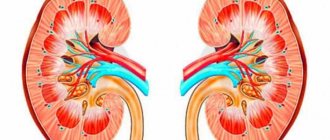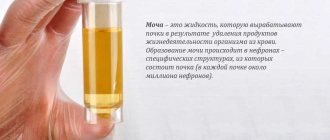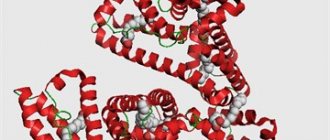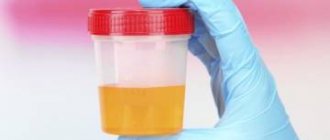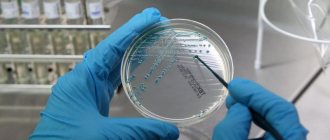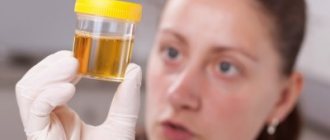A three-glass urine sample is a clarifying test that is prescribed if there are abnormalities in a routine study. Dividing urine into portions is more informative and allows you to find out in which part of the urinary system inflammation has developed. With the first portion, the microflora of the urethra is washed away, with the second - from the upper urinary tract, and with the last - from the bladder. In this way, it is possible to relatively accurately determine the location of inflammation: kidneys, ureters, bladder, urethra.
What is the three-glass test used for?
As mentioned above, the three-glass test is not an independent diagnostic method, but is used as a supplement to a general urine test or Nechiporenko’s test.
With correct and strictly regular collection of material, the sample helps the doctor to guess the level of localization of the pathological process in the urinary organs (urethra, kidneys or bladder).
Today, a three-glass urine sample is practically not used, which is associated with the advent of more informative diagnostic techniques, such as ultrasound, cystoscopy, cystography, urography, computer diagnostics, etc.
One of the significant disadvantages of the sample is its low information content, especially if the material for research is collected incorrectly.
The classic three-glass test is usually performed in men, when the entire portion of morning urine is collected alternately into three containers in a set ratio. The volume of the second portion should prevail (½ of the total collected material), while the first and third portions constitute ¼ of the volume each.
In women, due to the anatomy and topography of the urinary system, a three-glass sample is usually modified into a two-glass sample (urine is collected in only two containers).
3-glass sample: what shows how to collect
What kind of analysis?
A special feature of this urine test is the collection of material: urine is collected in 3 containers in a certain volume, each of which indicates the condition of a specific organ of the urinary system. The first 50 ml of urine is retained in the urethra, the next 150 ml in the bladder, and the last 50 ml in the prostate or cervix. A 3-cup urine sample is examined visually and under a microscope. In this way, specialists determine the external features and composition of the sediment of each portion of the biomaterial, which makes it possible to identify in which part of the organ there is inflammation. Based on the results, targeted treatment is prescribed.
Why is it needed?
If the result of OAM indicates an excess of leukocytes (blood cells that are an indicator of the body’s fight against pathogenic microorganisms), then to verify the diagnosis the patient is sent for analysis according to Nechiporenko. When the second laboratory test notes more than 2 leukocytes in the field of view, inflammation in the genitourinary system is confirmed. To find out in which organ the infection is present, the patient is prescribed a three-glass urine test.
Who is the test prescribed for?
The test is prescribed by a doctor if a pathology of the urinary system is suspected. So, a test can be prescribed when:
- 1Detection of leukocyturia, hematuria, bacteriuria or abnormalities in the number of epithelial cells in the field of view in a general urine analysis.
- 2 Suspicion of prostate pathology, as a method of additional diagnostics.
- 3The patient has symptoms of urethritis, cystitis, nephritis.
- 4 Presence of pathological (purulent, serous, bloody) discharge from the urethra.
- 5 Frequent urination at night.
- 6 Increased frequency of daytime urination.
- 7 Recurrent pain in the lumbar region.
- 8The presence of pathological impurities in the urine.
Indications and contraindications for the test
When a person consults a doctor with complaints about problems of the urinary system, the patient is first of all prescribed a general urine test, which, if there is a problem in the body, shows whether there are abnormalities in the components of urine or not. If deviations are detected, then a three-glass test is necessary to clarify them. As a rule, after general tests and the results obtained, a further consultation with the patient is carried out by a urologist, who, based on general symptoms and the results of preliminary general tests, prescribes a three-glass urine sample. This need arises when:
- increased number of leukocytes in urine;
- detection of blood impurities in the urine;
- a large number of epithelial cells in the urinary sediment;
- with purulent impurities;
- presence of protein;
- pathological discharge from the urethra;
- painful sensations in the lumbar region;
- frequent trips to the toilet for minor needs, with pain and burning;
- frequent urination at night.
In addition, the doctor may order a three-glass test if, during examination of the patient, there are suspicions of an inflammatory process in the kidneys, bladder, walls of the urethra, as well as the prostate gland, or the development of tumors and polyps.
It is strictly forbidden to test women during menstruation, as the result will be unreliable.
Preparing for the study
Long-term preliminary preparation of the patient for taking a three-glass sample is not required. All necessary preliminary procedures are carried out in the morning on the day of collecting the material and submitting the analysis.
It is necessary to prepare in advance three clean sterile containers, which should be numbered according to their serial numbers (1, 2 and 3). The numbering on containers must be clear and understandable, which will prevent them from being mixed up during transportation.
It is not recommended to use previously used containers; this may reduce the diagnostic value of the study. It is best to purchase containers specially designed for this at the nearest pharmacy chain.
Figure 1 - Sterile urine collection container
If it is not possible to buy ready-made sterile containers, then you can use containers with an extended neck. Urine is collected immediately into a jar, which will subsequently be delivered to the laboratory, without subsequent transfusions.
Before donating urine you must:
- 1Refrain from urinating for 5-6 hours, it is optimal to use the first morning urine.
- 2Hygiene the external genitalia with warm water, without using soap or disinfectants.
- 3Open and place containers for collecting material on a stable surface, according to their serial numbers.
- 4Men, before urinating, need to completely push back the fold of skin and expose the opening of the urethra. For women, spread the labia, preferably covering the vaginal entrance with a tampon. You should not collect urine during menstruation. Even urine collected one or two days before menstruation may not be diagnostically informative.
- 5 Severely immobile or paralyzed patients are washed with warm water from front to back, then wiped dry with a sterile gauze swab, sterile napkin or disposable towel. Wiping is also done from front to back.
- 6If you regularly take medications, you should tell your doctor about this before interpreting the result or ordering a test. Cancellation of medications, even if they have the property of changing the color of urine, should not be carried out. Modern diagnostic devices easily differentiate changes in urine as a result of pathology of the urinary system from changes when taking medications.
- 7If the purpose of prescribing a three-glass test is to diagnose prostate diseases, then before urination you can massage the prostate gland to increase the information content of the analysis.
Indications for use
A 2-glass urine sample is usually prescribed to men to clarify the localization of the pathological process. Indications for the study are high leukocytosis, the presence of red blood cells, and other impurities in a general clinical urine test.
The results of the analysis are used to make a diagnosis in urology or nephrology.
The doctor prescribes a 2-glass test if the following pathologies are suspected:
- pyelonephritis – the source of inflammation is located in the kidneys;
- cystitis - inflammation of the bladder;
- injuries to the kidneys and other organs of the urinary system;
- glomerulonephritis – autoimmune kidney damage;
- prostatitis;
- urethritis - damage to the mucous membrane of the urethra;
- prostate adenoma - hyperplasia of the gland;
- cancer of the urinary system;
- neoplasms of benign origin – kidney cysts;
- other diseases – urolithiasis, pyelitis.
The study can also be carried out to monitor the effectiveness of therapy and during a general examination of the body’s condition.
A feature of this test is the inconvenience of collecting biomaterial. No more than 60 ml of urine should go into the first container, and the rest into the second. The total volume in 2 glasses is 100 ml.
There are no absolute contraindications to sample collection. Only menstrual bleeding in a woman is relative.
But in emergency cases, the analysis is carried out on the condition that the vagina is covered with a tampon during the collection of biological material.
How to properly collect urine for research?
After all the preparatory procedures have been completed, it is necessary to urinate alternately into each of the three containers in one act of urination. It must be remembered that the second portion should make up a little more than half of the total analysis.
In other words, you should urinate a little in the first jar, then collect the bulk of the urine in the second, and fill the third with the rest of the urine. Women can split their urine into two portions. At the end of collecting the material, a portion of morning urine should be distributed among three containers in an approximate proportion of ¼, ½, ¼.
Under no circumstances should you take medium portions and pour the initial part of urine into the toilet! There is also no need to mix containers with each other or pour urine into three containers from one!
Filled containers should be tightly closed with a lid and delivered to the laboratory as soon as possible along with directions for analysis.
Already in the laboratory, urine is examined, the number of formed elements of urinary sediment is counted using a microscope, pH and density of a specific portion are measured, and the level of bacteriuria is assessed. All of the listed urine parameters are assessed separately for each portion and entered into the referral form.
Analysis methodology
Containers containing urine are accompanied by a direction for analysis. In laboratory conditions, the color and transparency of the biological fluid are visually studied, then the number of leukocytes and erythrocytes in the urinary sediment is counted using a microscope. In addition, the laboratory studies the reaction of urine, determining whether it is acidic or alkaline. Using a chemical reaction, the presence of protein in the urine, the amount and nature of the bacterial sample are detected.
Note that all the above criteria are determined for each portion of urine and recorded in a special form.
Storage and transportation
Urine sent for testing is stored for no more than 2 hours; the use of preservatives or freezing is undesirable.
Prolonged standing of urine leads to changes in its physical properties, abundant proliferation of bacteria and destruction of urinary sediment elements (red blood cells, white blood cells). In addition, the longer urine is stored, the higher its pH.
This occurs due to an increase in the concentration of ammonia released by bacteria during metabolism. Bacteria in urine also tend to consume glucose, so the level of glucose in urine may also be low if storage parameters are not followed.
Exposure to sunlight is also important, since, for example, bile pigments are destroyed in the light.
If urine is to be stored for more than 2 hours, the material should be kept in a dark, cool place. It should be remembered that the analysis result in this case may not be accurate.
Decoding the results
The norm corresponds to the physiological indicators of general clinical urine analysis. Changes found in the first portion indicate urethritis, the consequences of injury, and neoplasms in the lower parts of the urinary system.
But this is the case if the urine levels in 2 servings are not changed.
Changes in indicators in the sample from glass No. 2 are characteristic of inflammation of the prostate and bladder. If a deviation from the norm is found in both portions, then kidney and ureter diseases are suspected.
Table. Two-glass urine sample: normal.
| Indicators | Values |
| Color | Yellow |
| Smell | Present, mild, not offensive |
| Transparency | No visible inclusions |
| Density (g/l) | 1012–1022 |
| Protein fractions | Absent, morning urine may contain up to 0.033 g/l |
| Sugar (mmol/l) | Less than 0.8 |
| Acetone, bilirubin | Not found |
| Red blood cells | 1–2 in the field of view, ideally absent. The amount may increase due to increased loads, after stressful situations. |
| Hemoglobin | Not detected |
| Leukocyte counts | Women, children - up to 6, men - up to 3 in sight. White blood cell levels increase during pregnancy |
| Epithelial cells | A small amount - less than 10 in the field of view |
| Cylinders, urates, oxalates, phosphates | Hyaline casts may be detected in small quantities - 1 in a man, up to 4 in a woman. No other species, no salts detected |
| Yeast, parasites | Not defined |
If the indicators differ from normal, then the patient needs to see a doctor and undergo a comprehensive examination. After treatment of the underlying disease they return to normal.
Interpretation of the three-glass sample
When interpreting the results of a three-glass test, two main indicators of urine are usually assessed: hematuria and leukocyturia.
There are three types of hematuria and/or leukocyturia:
- 1Initial - the presence of leukocytes and/or erythrocytes mainly in the first portion of urine.
- 2Terminal - the presence of leukocytes and/or erythrocytes mainly in the last portion.
- 3Total - pathological disorders are equally expressed in all three portions.
An increase in white blood cells and/or red blood cells in portions may indicate the following conditions:
- 1 Deviations are observed exclusively in the first portion: the pathology is located in the anterior part of the urethra. Most often this occurs with inflammation of the urethra (including specific), its polyps, damage, and wounds.
- 2 Deviations only in the last portion of urine - localization of the pathological process in the bladder, terminal urethra, bladder neck, prostate or seminal vesicles. Among the diseases, the most common are chronic prostatitis, cystitis (including cervical cystitis), and bladder tumors.
- 3The presence of abnormalities in all portions indicates involvement of the kidneys, ureters, and bladder. This situation can be observed with nephritis and nephropathies, pyelonephritis, injuries of the kidneys and ureters, urolithiasis, tumors of the kidneys and bladder, chronic cystitis.
The essence of the study
When conducting a general analysis of urine, the detection of an increased content of leukocytes in it allows one to suspect the presence of an inflammatory process in the kidneys, ureters, bladder, urethra, and in men also in the prostate gland. A three-glass urine sample is designed to help localize the focus of the pathological process and establish the location of the lesion. The three-glass test is an additional research method after a general urine test has been performed and according to Nechiporenko, it is never prescribed independently. The essence of the method is to sequentially collect urine into three special containers for collecting urine during one act of urination. In this case, it is not allowed to collect urine in one container and then pour the contents of the container into three jars; it is not allowed to pour urine from one jar to another. It is also important to maintain the proportions of the collection.
A three-glass urine sample is not an independent test; it is indicated after detection of an increased content of leukocytes and erythrocytes in a general urinalysis
A three-glass test helps to establish the localization of the lesion - so, if leukocytes and red blood cells are detected only in the initial portion, we are most likely talking about a pathological process in the urethra, in the last container - the bladder. If hematuria (the presence of red blood cells in the urine) and leukocyturia are observed in all three samples, the kidneys are most likely affected. The advantages of this method include simplicity, accessibility and low cost. However, there are a number of disadvantages - low information content, high probability of violation of urine collection technique, and mixing up containers. At the present stage, most information about the localization of the lesion process can be obtained by ultrasound, cystoscopy, urography, computed tomography, but we should not forget about the rather high cost of these studies and the difficulty of carrying out some manipulations (for example, cystoscopy) in children.
Reasons for false results
The reliability of a three-glass sample directly depends on proper preparation for the study and compliance with all stages of collecting material.
Compared to a conventional urine test, this test is difficult for the patient to understand. Even a detailed explanation of the essence of the study does not always lead to compliance with all recommendations for urine collection, which makes the reliability of the analysis and its diagnostic value extremely low.
Main reasons for false results:
- 1Insufficient preparation.
- 2Lack of container labeling.
- 3 Mix-up of samples during storage and transportation.
- 4 Mixing different portions together.
- 5 Pouring urine into three portions from one common container.
- 6 Violation of storage and transportation rules.
If typical deviations in the results of a three-glass sample are identified, additional, more accurate studies are recommended.
Treatment of abnormalities
A two-glass urine sample is a quantitative research method and is used to determine the location of the pathological process, as well as its nature. It is most widespread in urological practice when examining men. If the results of the analysis exceed the norm, then to establish a diagnosis and prescribe treatment, you must contact your attending physician - urologist, nephrologist. To avoid distortion of indicators due to the influence of physiological factors, you must follow all the rules for preparing for urine collection.
How to take it correctly
You need to collect the material in the morning, immediately after a night's sleep. If the patient suffers from insomnia problems, then he is allowed to collect it four hours after the last urination.
Before starting the procedure, the patient must carry out standard hygiene procedures for the genitals, without using detergents (soap, intimate hygiene gel, etc.). Sterile containers, sold in every pharmacy, are used as test vessels.
The dishes are pre-signed - samples No. 1 and No. 2. The patient completely empties the bladder, gradually filling each of the vessels. The volume of the first portion must be at least 30 ml, the second - at least 70 ml. The total amount of urine should exceed the 100 ml mark.
Prepared tests are stored in a room with a temperature no higher than 25 degrees for no more than a day. Long-term storage of collected urine contributes to changes in chemical properties due to the activation of bacterial activity. For accurate results, the laboratory recommends delivering filled containers within several hours.
What does a two-glass urine sample show?
The sampling is carried out from each container, the resulting material is studied separately. Each sample is a unique carrier of information about certain areas of the urinary tract.
The primary portion provides general information about the condition of the lower organ – the urethra. Secondary - reports pathological abnormalities in the prostate, bladder and ureters.
Obtaining large amounts of information is the main difference between the method and standard clinical analysis. The results of a general clinical urine sample may be influenced by other pathologies and diseases occurring in the patient’s body.

